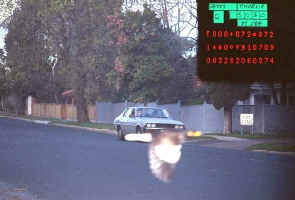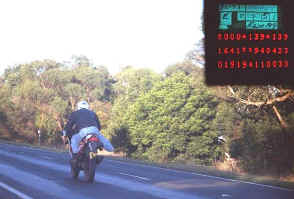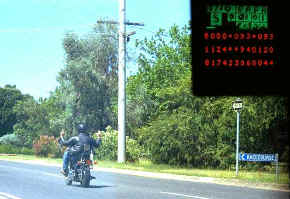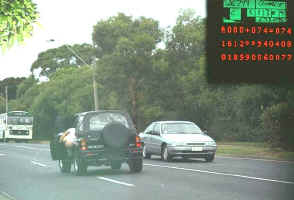Chapter 33: SPEED

Worldwide 5 - 15% of all crashes are due to excessive speed.
A recent study by the British Transport Laboratory has found that excessive speed was a factor in fewer than 5% of more than 3000 traffic accidents analyzed. Driving associations in Britain are in uproar as these findings were ignored by the government that went onto speed £ 34 million on the "Kill your Speed" campaign launched in January 1999.
The danger is that government's worldwide continue to target speed and fool drivers into the misconception that safe driving is simply slower driving.
There is a worldwide push to continually lower speed limits and increased speed enforcement and penalties. We are fast reaching the time when drivers and car makers will revolt at the "big brother" controls on personal freedom.
Of the speed related crashes 70% are single vehicle accidents. Therefore it is true that speed is a large cause of driver error, driving too fast for the road, too fast for the conditions, too fast for the car or too fast for the driver.
Each year speed related crashes cost Australia in excess of $1 billion.
A significant amount of research has been undertaken to measure the effects of speed and crash involvement.
CREATED BY: CARL TAYLOR www.ctx1.tripod.com/driving
This research has indicated that there exists a high danger associated with large deviations in individual vehicle speeds from the average speed of the the traffic system on any particular road.
Queensland Transport highlights that driving 25 km/h faster than the surrounding traffic increases your risk of crashing by 10 times, no matter how good you are as a driver.
As such speed variance and not average travel speed influences the level of crash involvement. If all the traffic was flowing at 140-150 km/h the risk of a crash would be alot less than the traffic flowing at 105 km/h with several drivers weaving through the traffic at 140 km/h.
In Germany with its autobahns, there exists (when weather and traffic permits) open speed limits. The danger here is not the speed of travel its the cars traveling faster or slower than the surrounding traffic.
YES, slow vehicles have been shown to also increase the risk of a crash occurring.
Some research has shown that traveling 20 km/h slower than the surrounding traffic is just as dangerous as traveling 40 km/h faster. In fact low speed drivers are more likely to cause and be involved in an accident than high speed drivers. This has led to a call for both minimum and maximum speed limits to be set and enforced!
So how does this relate to the SPEED KILLS or ARE YOU DRIVING TOO FAST FOR THE UNEXPECTED message.
I guess we have all been mislead by the police and road safety experts into thinking that high speed driving automatically is dangerous.
If the majority of Australians were better trained and educated as drivers and if our road system was designed for it, higher speed limits (outside urban areas) would reduce the number of crashes occurring.
FOR EXAMPLE:
Image an open wide dual lane road with new bitumen that has a posted speed limit of 60 km/h. Research has shown that drivers adopt a travel speed according to the perceived risks. In this case the road environment is indicative of a low risk level.
Well at SAFE DRIVE TRAINING we believe there is two types of speeding;
1. THE DRIVERS WITH NO IDEA:
These are the drivers that attempt to drive along a busy road faster than everyone else. These drivers are characterized by rapidly changing lanes, tailgating and driving aggressively, they are also the ones that end up at the next set of traffic lights 2 cars in front of you. They basically waste alot of their money and effort for very little reward. Here speeding is dangerous.
2. THE RESPONSIBLE DRIVER:
These are the drivers that take the time to ensure that their vehicle is well maintained and they drive according to the conditions and the flow of traffic. These drivers try to always obey speed limits and only increase speed if their actions don't impact on anyone.
OTHER POINTS OF VIEW:
Dr. Ingo Kallina the head of safety research for Mercedes Benz has found "no link between speed and injury outcome. In Germany we have autobahns with unlimited speed and they are the safest". Dr. Kallina went on in his interview to question 110 km/hr speed limits and there effectiveness.
- "Even relatively minor increases over the speed limit can have serious consequences by increasing the risk of a crash and making crashes for severe if they occur" Inspector Peter Mansfield, Queensland Police
- I have read with amusement the stories about car dealers and misleading advertising. I find it ironic that government watchdogs monitor car dealers advertising then let Queensland Transport get away with false, or in the very least, unsubstantiated advertising. I refer to the ad that states speed cameras save lives and have reduce road fatalities. From where are these statistics derived? Furthermore, I would like to see real evidence that speed cameras have saved one life. I am not saying that speed cameras are not necessary. But let's hold our public servants to the same standard of honesty in advertising that we hold business. If Queensland Transport was to say that speed camera use is on the increase to slow traffic down, or catch more speeders, at least it would be believable. Maybe they don't want us to know the real reason for the cameras. Revenue enhancement perhaps? P.McDowall, Victoria Point
HOW SOME DRIVERS AVOID A SPEEDING TICKET:
- Don't speed. You are only running late because you left late.
- Bribe a feathered friend into following you around all day and flying in front of speed cameras
- Block your number plate with your foot as you ride past. Good luck
- Blacken out your number plate and leave a hand gesture as a sign of thanks
- Remove your number plate and have your passenger leave a message for police
The Top 20 Cool Things About a Car That Goes Faster Than The Speed of Light
- Sleep 'til noon. Still get to work by 8:00 a.m.!
- Doppler shift makes red traffic lights look green.
- Breaking laws of physics only a misdemeanor in most states.
- Never in car long enough to hear an entire Madonna song.
- Carl Sagan and Stephen Hawking keep bugging you to carpool.
- No one can see you pick your nose while you drive.
- Lunch breaks in Paris, circa 1792.
- LA to Vegas in 2 nanoseconds.
- You can stop worrying about being sucked into a black hole while driving home from work.
- You'll be so thin while driving it you can even wear horizontal stripes.
- That deer in your headlights is actually behind you.
- Traffic enforcement limited to cops with PhDs in quantum physics.
- Bugs never see you comin'.
- You can get to the good hookers before Charlie Sheen.
- Can make a fortune delivering pizza with the slogan, "It's there before you order or it's free!"
- Car makes it from Hollywood to London fast enough to not arouse suspicions of Elizabeth Hurley.
- License plate: "Me=mc^2"
- Cigarette butts don't land in the back seat -- they land in last week!
- The more you drive, the younger you get.
- Chicks dig it.
(Written by Joel Neilsen, Managing Director, Safe Drive Training)





